If you are a fan of Japanese cuisine, you have probably heard of the renowned sushi from the land of the rising sun. More than just a dish, sushi is considered a delicate culinary art of the Japanese people. So, what is sushi? What are the popular types of sushi? Let’s explore this unique and famous delicacy from Japan in more detail with Kamereo!
What is Sushi?
Sushi is a traditional Japanese dish, a delicate combination of vinegar-flavored rice, seafood ingredients, and other accompaniments. Specifically:
- Vinegar-flavored rice (Shari or Sushimeshi): This is the core component of sushi, determining its distinctive flavor. The rice used is typically short-grain Japanese rice with high stickiness. After cooking, the rice is mixed with Sushisu, a mixture of rice vinegar, sugar, salt, and mirin.
- Seafood ingredients (Neta): Neta includes fresh or processed seafood placed on top of the shari rice. Popular neta varieties include tuna (maguro), salmon (sake), shrimp (ebi), eel (unagi), squid (ika), octopus (tako), scallops (hotate), and more. Each seafood type offers a unique flavor and texture.
- Other accompaniments:
- Besides rice and seafood, sushi may include vegetables like cucumber, avocado, pickled radish, etc., to enhance flavor and color.
- Nori seaweed is another essential component, often used to roll sushi (maki sushi) or shape other sushi types.
- Pickled ginger (gari) and wasabi are indispensable condiments, balancing flavors and neutralizing any fishy odors.

Origin of Sushi
Sushi actually originated in Southeast Asia about 1100 years ago. The earliest name was Narezushi, appearing in the ancient Japanese law book Engishiki in 927, meaning “preserved food.” During this period, Narezushi was made by fermenting raw fish with rice and salt, extending its shelf life.
After being introduced to China, this preparation method was brought to Japan. Gradually, sushi became a popular dish for special Japanese occasions. According to legend, offering a girl sushi was a way for a young man to express affection and respect. Today, sushi has gained global popularity and undergone many adaptations to suit modern tastes.
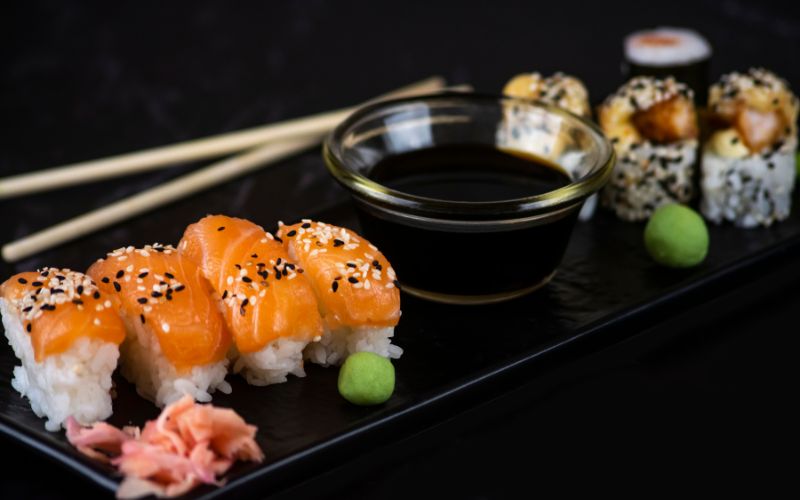
Types of Japanese Sushi
Here are 10 famous types of Japanese sushi, considered representative of the traditional sushi culinary essence of Japan:
Nare sushi
Nare sushi is known as one of the oldest sushi types in the world, reflecting the traditional preparation methods of ancient Japan. The main ingredients are freshwater fish like salmon and carp, heavily salted and undergoing a special fermentation process. The highlight of Nare sushi is the long fermentation time, resulting in a distinctive salty flavor that blends with the natural sweetness of the rice ball.
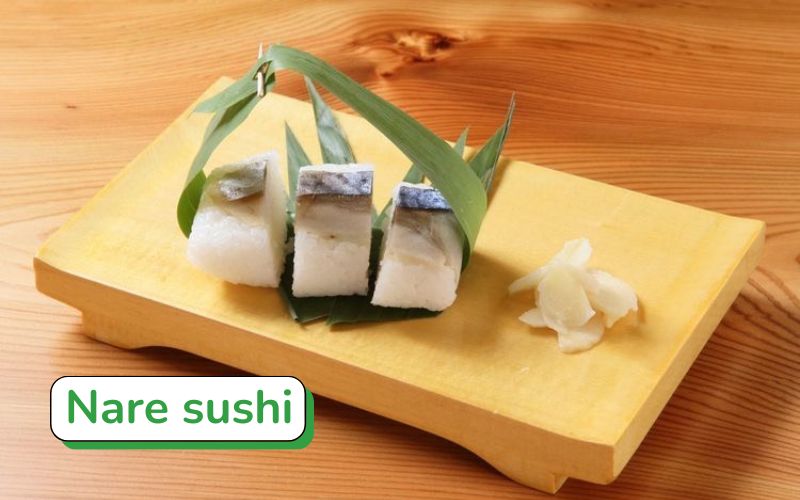
Temari sushi
Temari sushi has a round shape, similar to small balls, which is entirely different from the typical elongated shape of traditional sushi. Thanks to its simple preparation, Japanese people often make Temari sushi at home and bring it for picnics, Christmas, or Halloween.
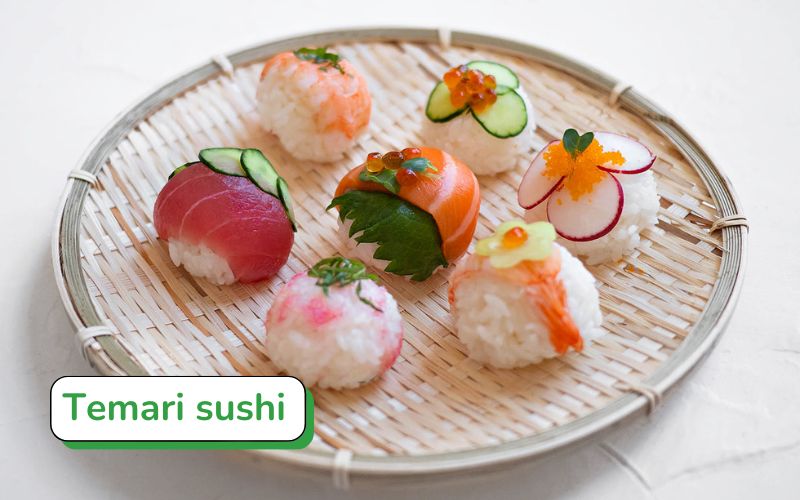
Futomaki sushi
Futomaki offers a flavor and preparation method somewhat similar to Korean kimbap. The filling is diverse, including fresh vegetables, fish cakes, eggs, and carrots, all rolled in white rice and seaweed. Originating from the Kansai region of Japan, Futomaki often appears at spring festivals, symbolizing freshness and prosperity.
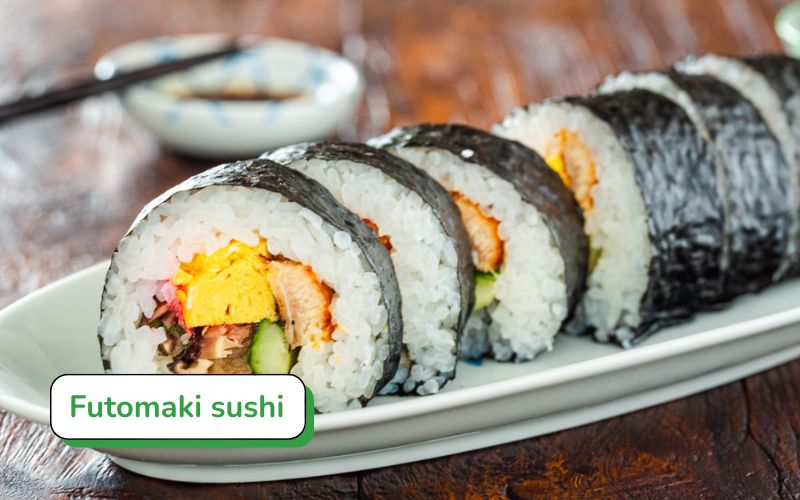
Hosomaki sushi
Hosomaki is considered the smallest type of sushi. This dish has a minimalist preparation, with white rice wrapped in seaweed and a filling that uses only one ingredient.
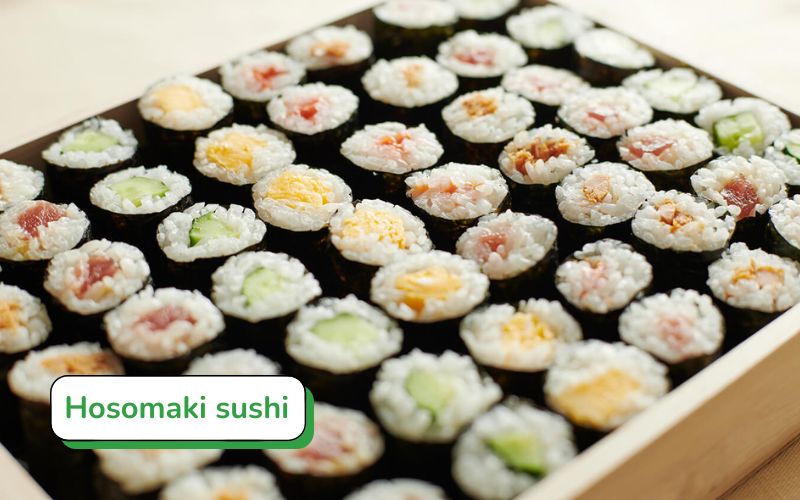
Temaki sushi
Temaki is also known as “hand-rolled sushi” because the preparation process uses only the chef’s skillful hands. With a unique cone-like or ice cream cone shape, Temaki offers an exciting culinary experience, combining the freshness of the ingredients and the skillful rolling technique.

Oishi sushi
Oishi sushi is a unique variation that does not follow the traditional rolling method with seaweed. Instead, the rice is pressed onto other ingredients, creating a layered cake shape. When eating, diners can cut them into small rectangular pieces to fully appreciate the flavor.
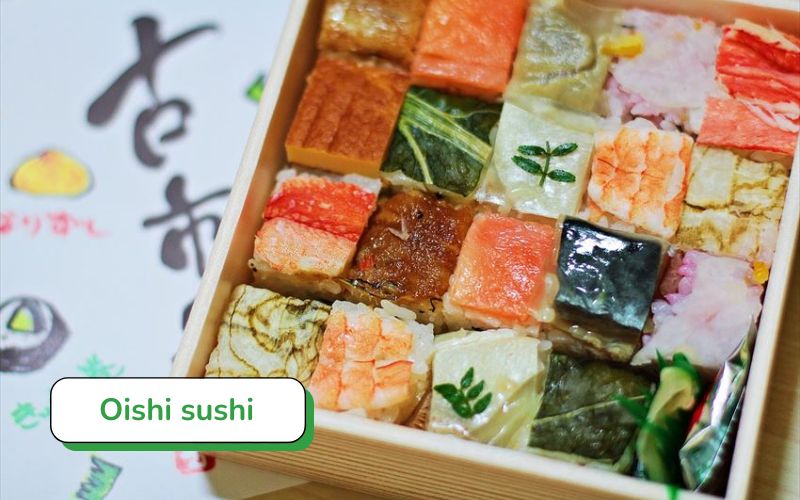
Nigiri sushi
Nigiri sushi is one of the most popular sushi types, loved for its simplicity and elegance. The rice, mixed with rice vinegar for a slightly sour taste, is then pressed into an oval shape. The highlight of nigiri sushi is the fresh seafood placed carefully on top of the rice.
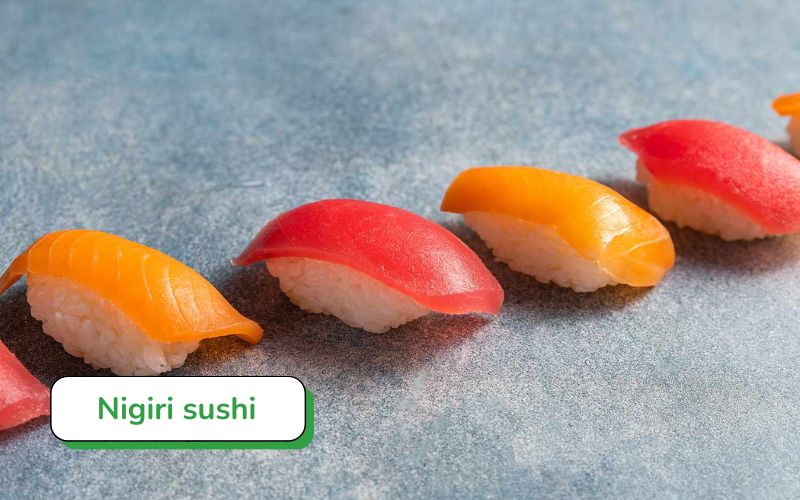
Gunkan sushi
Gunkan sushi has rice wrapped in seaweed, forming a small “boat.” On top are various toppings, from crab roe and salmon roe to chopped salmon, offering a rich flavor and color palette.
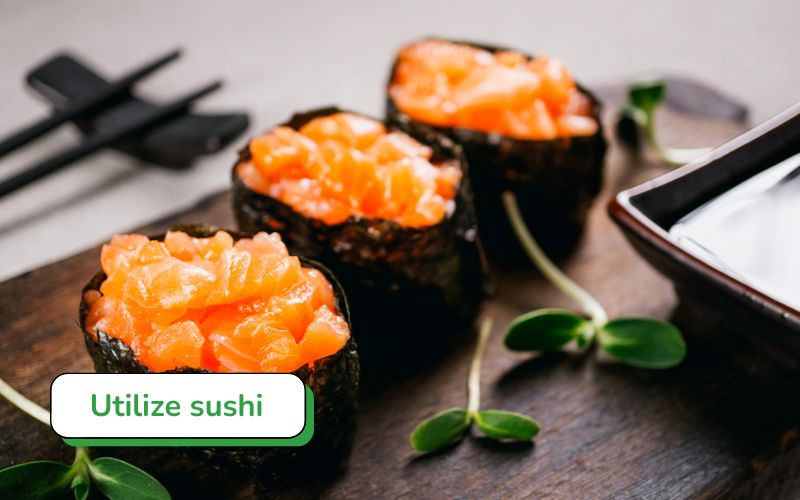
Chirashizushi
Chirashizushi is a unique variation of Japanese sushi, served in a large bowl, different from traditional sushi types. Rice is spread on the bottom of the bowl, topped with various toppings like meat, fresh seafood, and eggs.
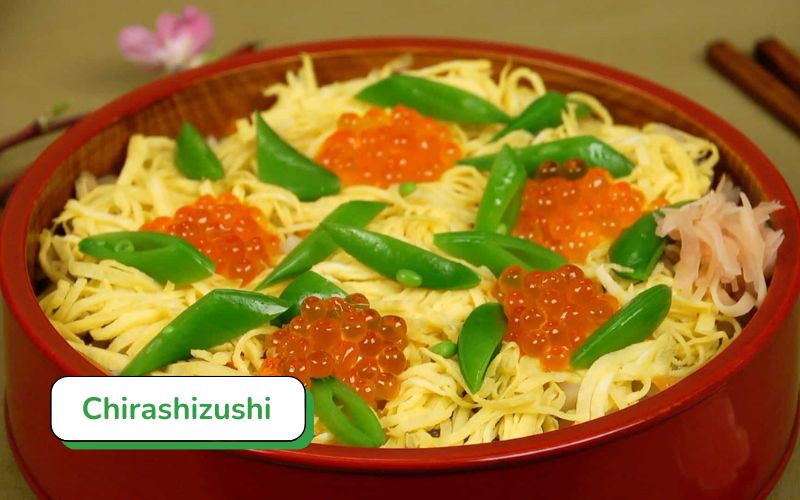
Inari sushi
Inari sushi is an interesting option for those wanting to try new flavors. Instead of using seaweed, inari sushi uses fried tofu (inari age) as the outer wrapper. The fried tofu wrapper is filled with vinegar-flavored rice and seafood, creating a unique combination of sweet tofu, sour rice, and fresh seafood.
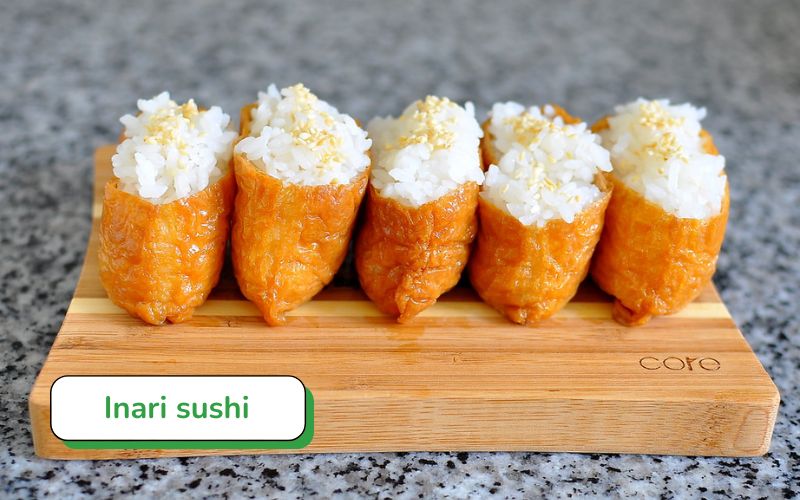
How is Sushi Different from Sashimi?
Sushi is a dish made from vinegar-flavored rice combined with various meats, fish, seafood (raw or cooked), and fresh vegetables. In contrast, sashimi does not use rice; it only consists of sliced fresh seafood served with Japanese perilla leaves, pickled pink ginger, shredded radish, and wasabi.
Sashimi is often served as an appetizer to preserve the fresh taste of seafood, while sushi can be the main course.
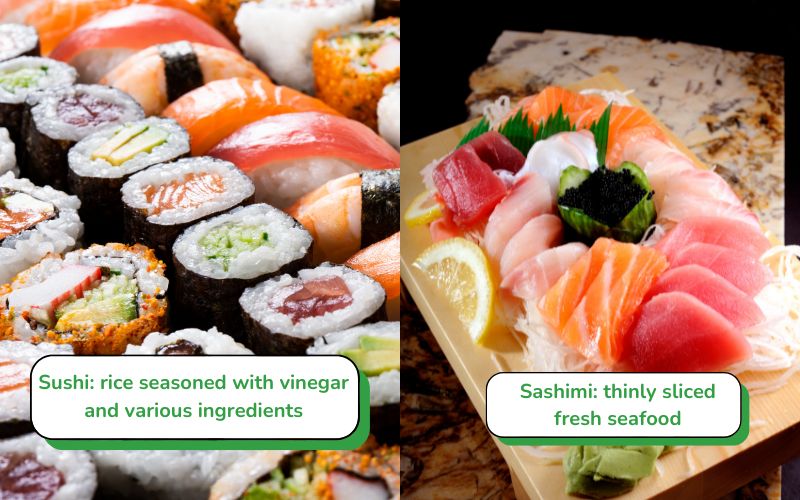
Here is a comparison table to help you easily distinguish between these two dishes:
|
Criteria |
Sushi |
Sashimi |
|
Main ingredients |
Vinegar-flavored rice, fish, seafood, fresh vegetables |
Fresh seafood |
|
Preparation |
Rice and ingredients combined in various ways (rolls, layers, rice accompaniment) |
Sliced seafood, eaten directly |
|
Course type |
Main course |
Appetizer or main course |
How are Sushi and Kimbap Different?
Sushi and kimbap both use seaweed and rice rolls but have distinct characteristics. Japanese sushi has a slightly sour vinegar-flavored rice, while Korean kimbap is fragrant and fatty from sesame oil. Sushi fillings are delicate with raw seafood, while kimbap has diverse fillings like sausage, yellow radish, crab sticks, and fish cakes, creating a richer flavor.
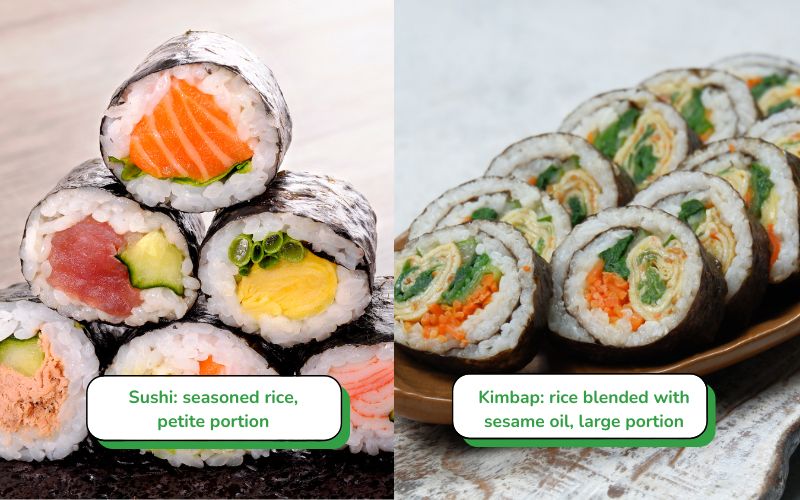
Additionally, Japanese sushi is often small and has fewer fillings, while kimbap is typically larger and has more fillings. When eating, sushi is dipped in soy sauce with wasabi to enhance the flavor, while kimbap is usually not dipped because it is already fully seasoned.
|
Criteria |
Sushi |
Kimbap |
|
Rice seasoning |
Rice vinegar |
Sesame oil |
|
Filling |
Raw seafood, fish roe |
Sausage, yellow radish, crab sticks, fish cakes,… |
|
Size |
Compact |
Larger |
|
Dipping sauce |
Soy sauce with wasabi |
None |
Kamereo – Japanese Standard Sushi Ingredients Supplier
Kamereo is a strategic partner of Gyomu Japan – a Japanese domestic supermarket chain. We bring authentic Japanese domestic sushi ingredients at competitive prices to F&B businesses. With the mission of simplifying the food supply chain in Vietnam, we pioneer as a technology-applied food supplier, providing convenient purchasing solutions, optimizing operations, and building a sustainable ecosystem.
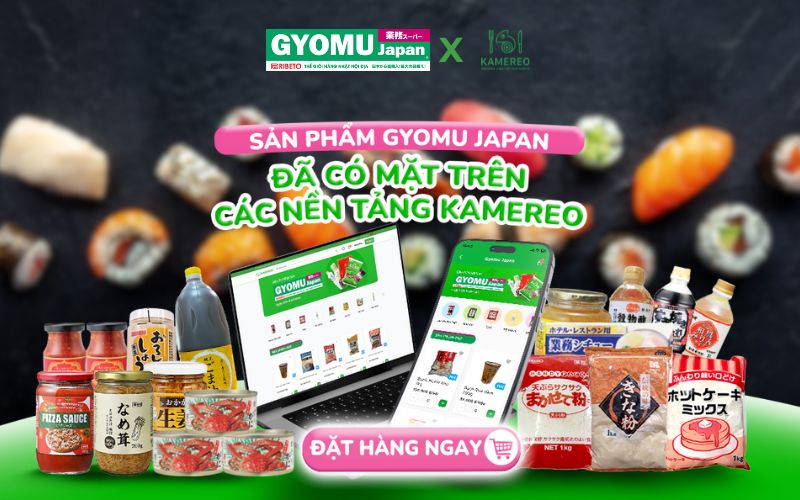
Kamereo focuses on optimizing every stage of the import process, from product search, ordering, cost control to delivery. We are committed to providing a stable supply, guaranteed quality, and transparent pricing. This eliminates businesses’ concerns about shortages or price volatility in the market.
The Kamereo website and application comprehensively optimize the purchasing and cost management process for F&B businesses. With Kamereo, you can order quickly, anytime, anywhere, manage multiple stores, approve orders, and track costs. This helps businesses optimize the procurement process, saving time and money.
We support order placement until midnight and deliver quickly before 6 am the next day, ensuring the store’s kitchen is always ready with ingredients for operation. Our return and exchange policy and co-inspection upon receipt also help businesses directly check product quality. If there are any issues, you can return or exchange immediately, saving time and ensuring satisfaction.
Bestselling Sushi Ingredients at Kamereo:
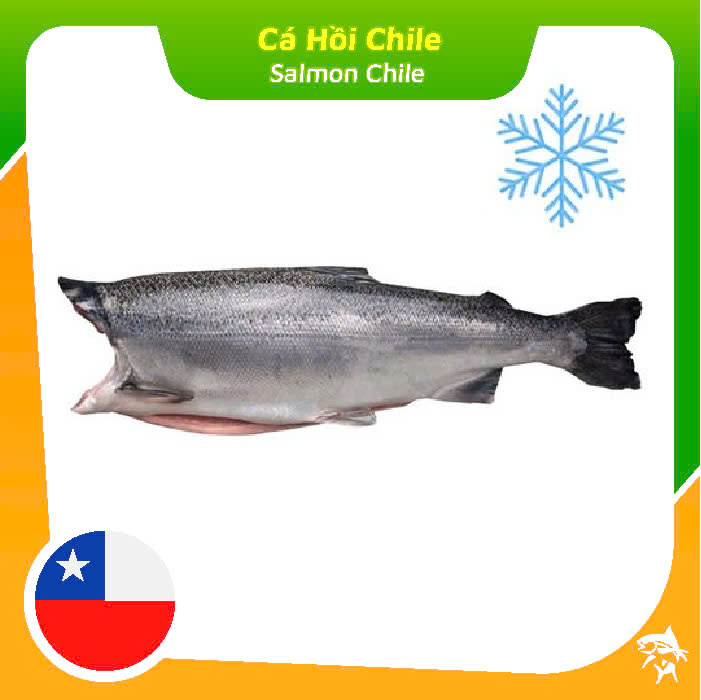
Frozen Whole Headless Salmon 4 - 5kg/ Piece (Purchase Piece Charged By Kg)
239,000đ/KILOGRAM
273,000đ/KILOGRAM
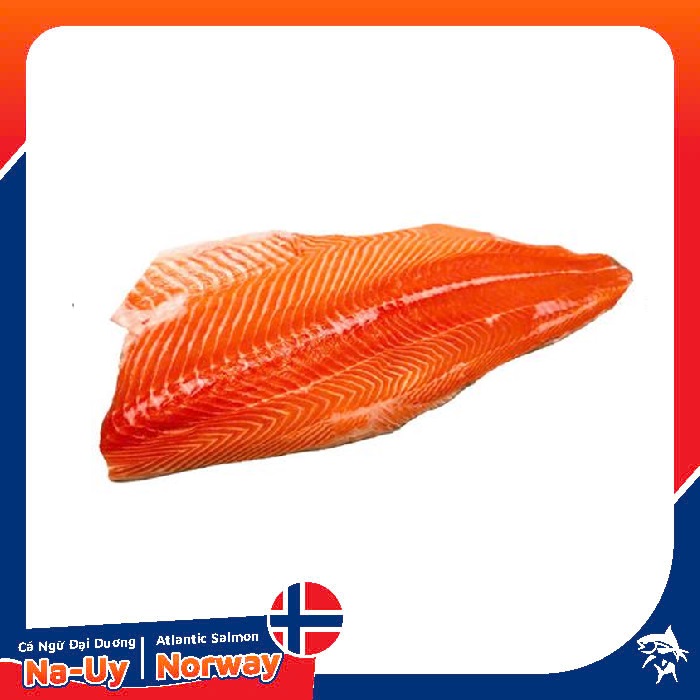
Fresh Salmon Fillet Size 2 - 2.5kg/ Piece (Purchase Piece Charged By Kg)
529,000đ/KILOGRAM
687,500đ/KILOGRAM

Fuji Japanese Rice 5kg
199,000đ/PACK
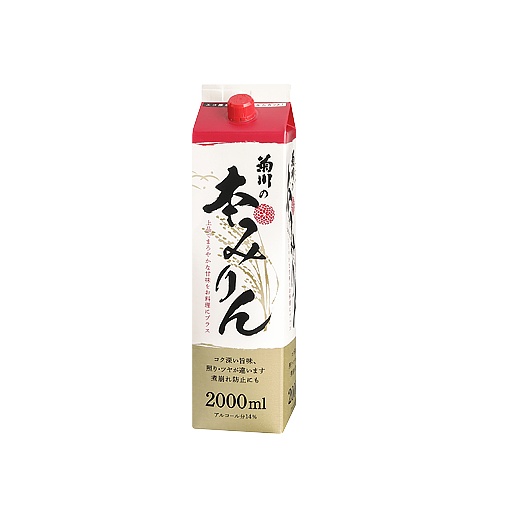
Hon Mirin Cooking Seasoning 2L
160,000đ/BOX

Hon Mirin Umami 880ml
69,000đ/BOTTLE
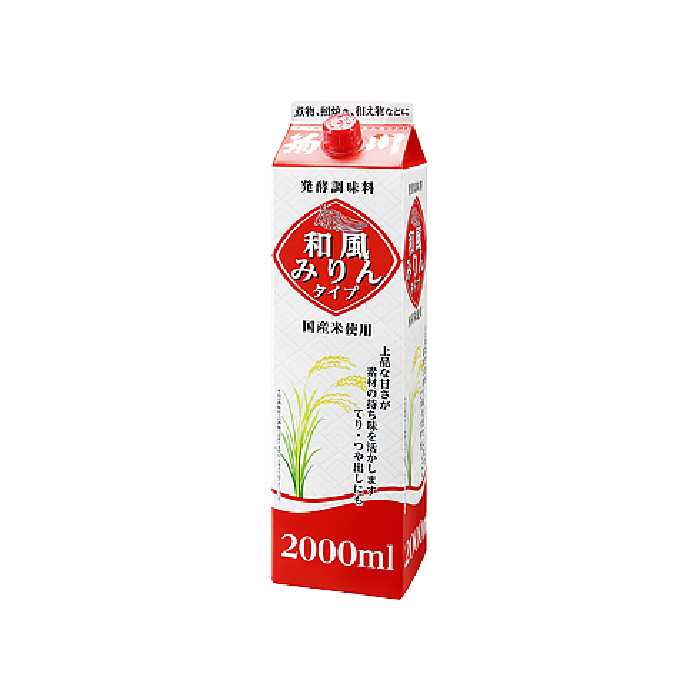
Kikugawa Mirin Cooking Wine 2L
85,000đ/BOX
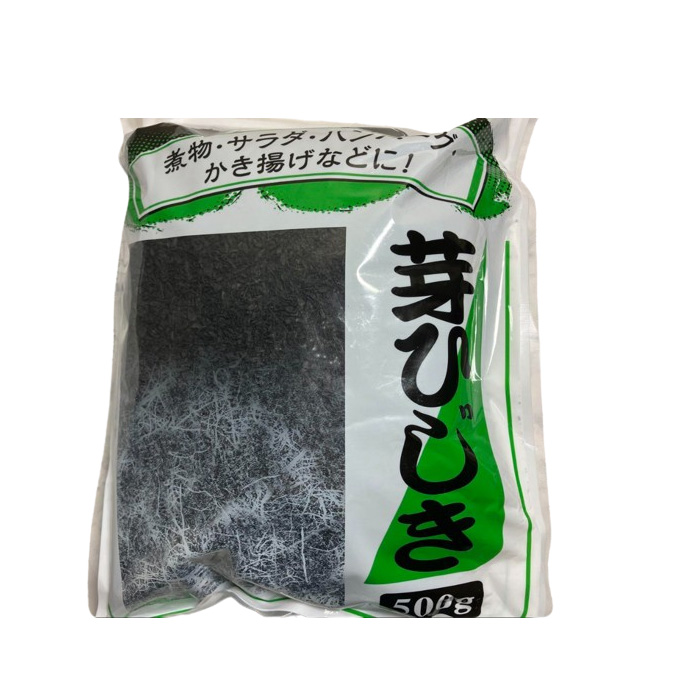
Hijiki Dried Seaweed 500g
205,000đ/PACK
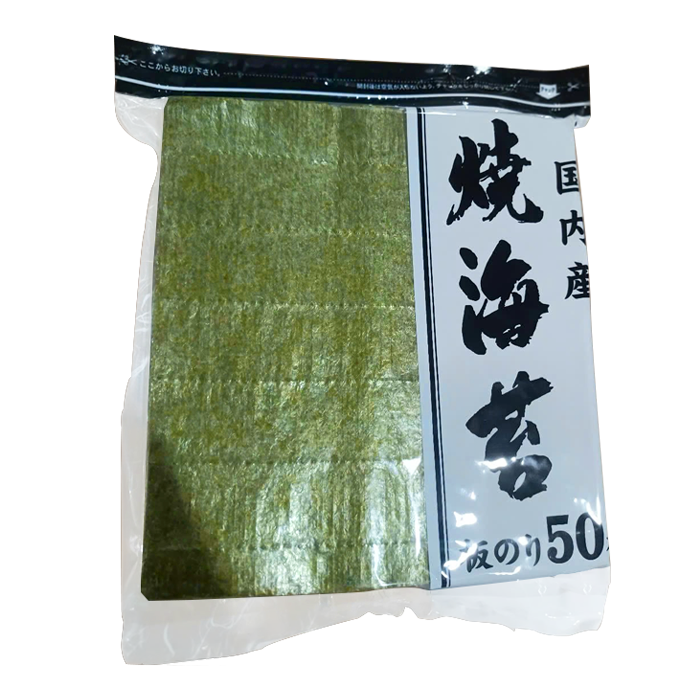
Sekiguchi Dried Seaweed (50 Sheets)
295,000đ/PACK
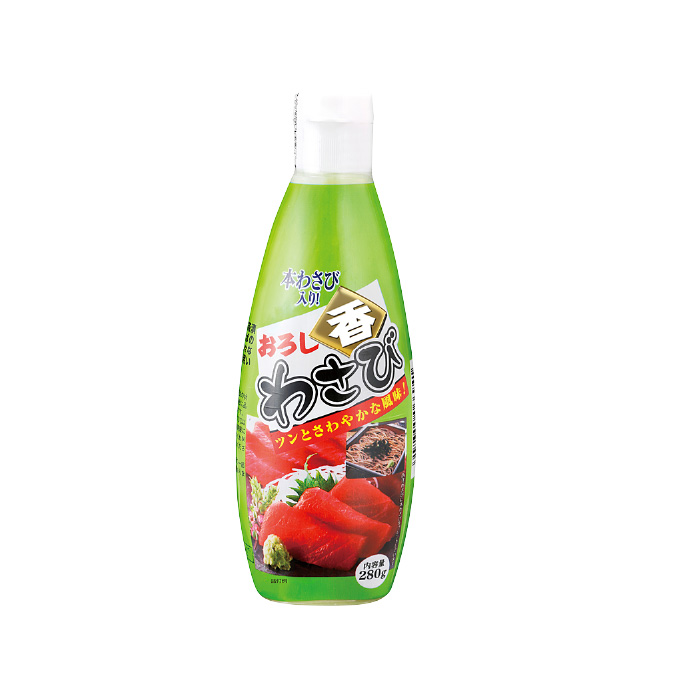
Bottled Wasabi 280g
105,000đ/BOTTLE
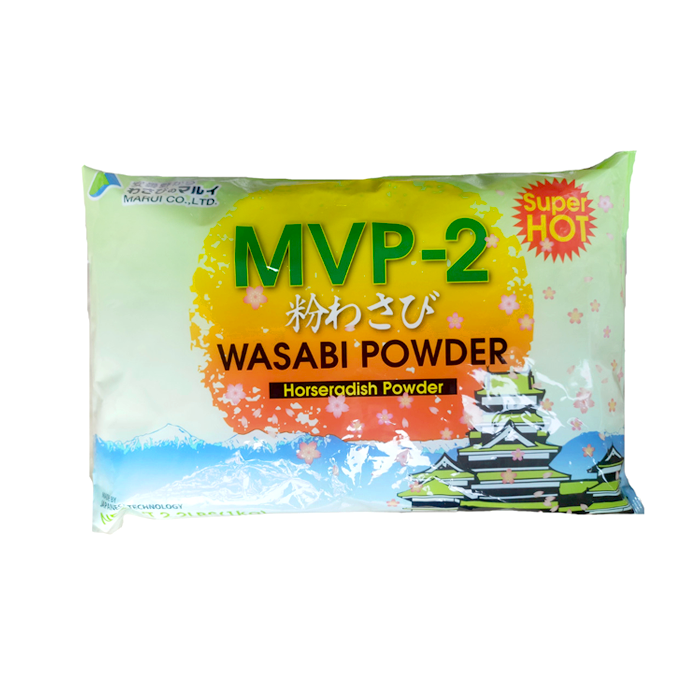
Marui Wasabi Powder 1kg
239,000đ/PACK
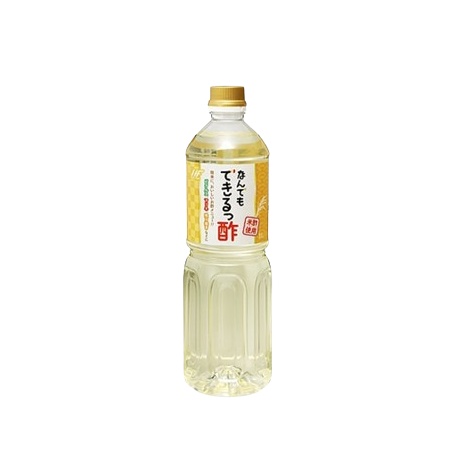
Hata Foods Cooking Rice Vinegar 1L
105,000đ/BOTTLE

Kobe Bussan Pickled Pink Ginger 100g
37,000đ/PACK
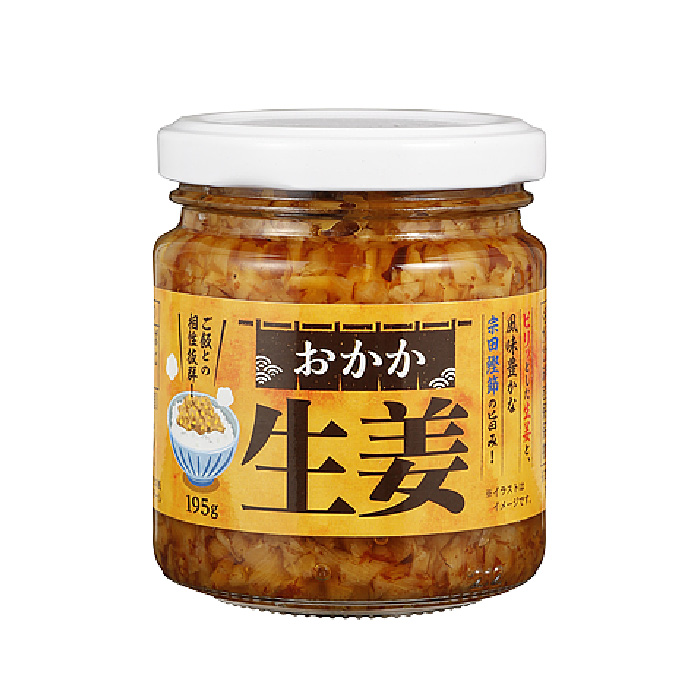
Pickled Ginger Seasoning 195g
55,000đ/JAR
Frequently Asked Questions
Which country does Sushi come from?
Sushi is a traditional, famous dish of Japan. Since ancient times, the Japanese have known how to marinate fish, shrimp, and seafood in rice for preservation and to enjoy the fresh taste.
What is Shari?
Japanese sushi consists of two main parts: “shari” – vinegar-mixed rice and “neta” – the ingredients placed on top of the sushi rice. This combination creates a distinctive delicious flavor, with sticky, non-crumbly rice.
What are the ingredients of Sushi?
Sushi’s main components are vinegar-mixed rice (shari) and other ingredients (neta). Neta can be fresh seafood (salmon, tuna, shrimp, squid…), roe, vegetables (cucumber, avocado, carrot…), or various meats. Sushi is presented in many forms such as nigiri, maki, sashimi…
Is eating Sushi healthy?
According to culinary experts, sushi is highly regarded for its nutritional value, health benefits, and easy digestibility. The main ingredients of sushi usually do not contain additives or preservatives, helping the dish maintain its natural freshness.
Conclusion
Above are the most detailed answers about what is sushi, as well as how to differentiate sushi from kimbap and sashimi. Hopefully, with this useful information, you can confidently enjoy this unique dish from the Land of the Rising Sun. Don’t forget to visit the Food and Lifestyle section to read more great and interesting articles!
See more:



